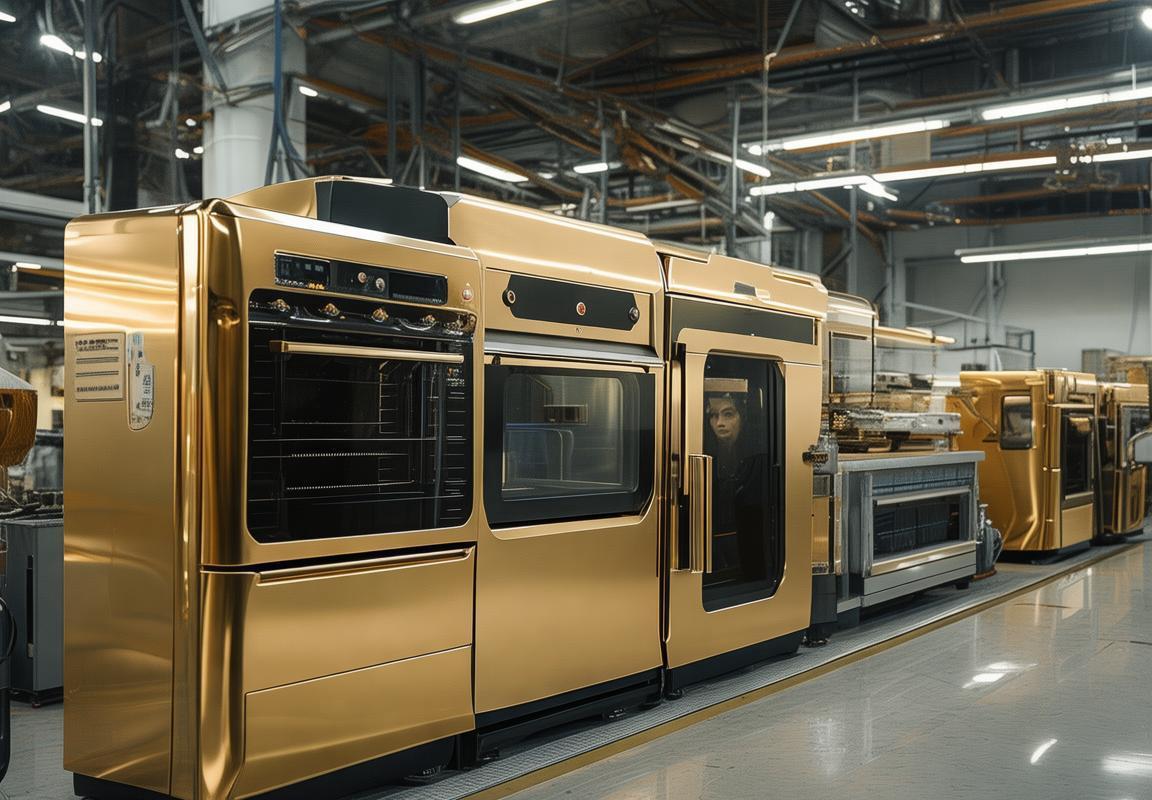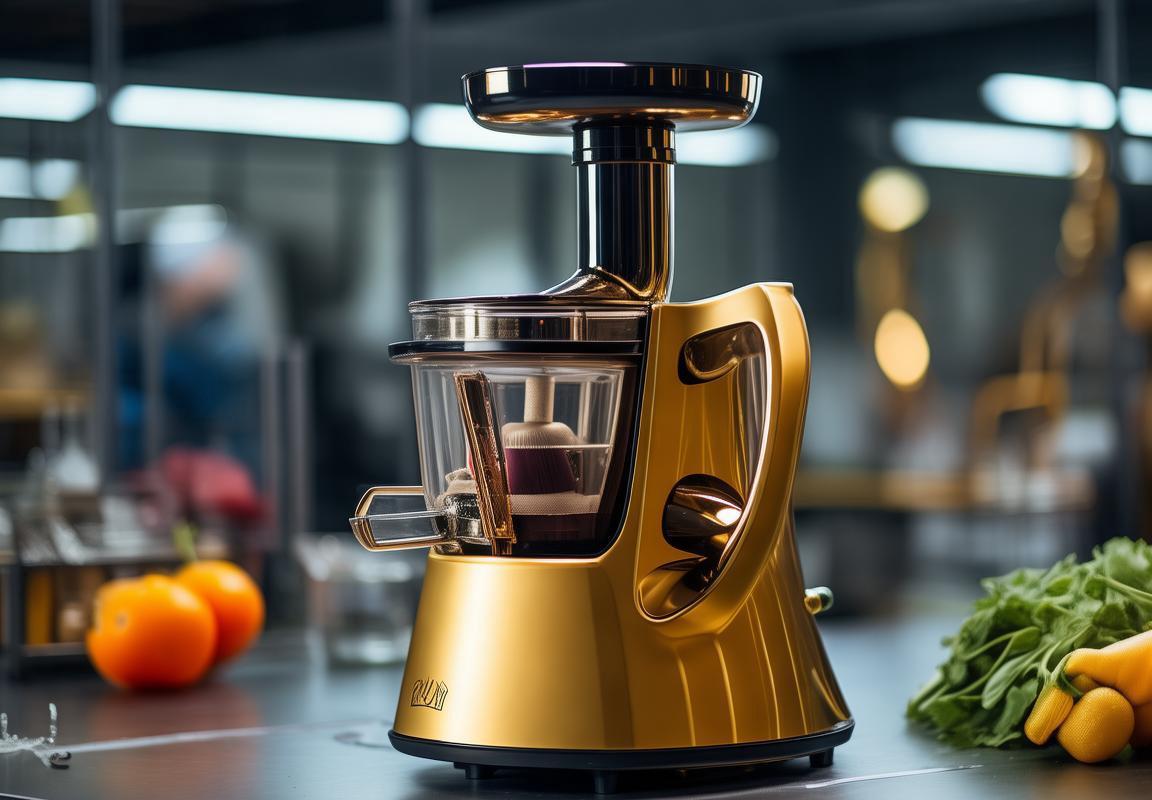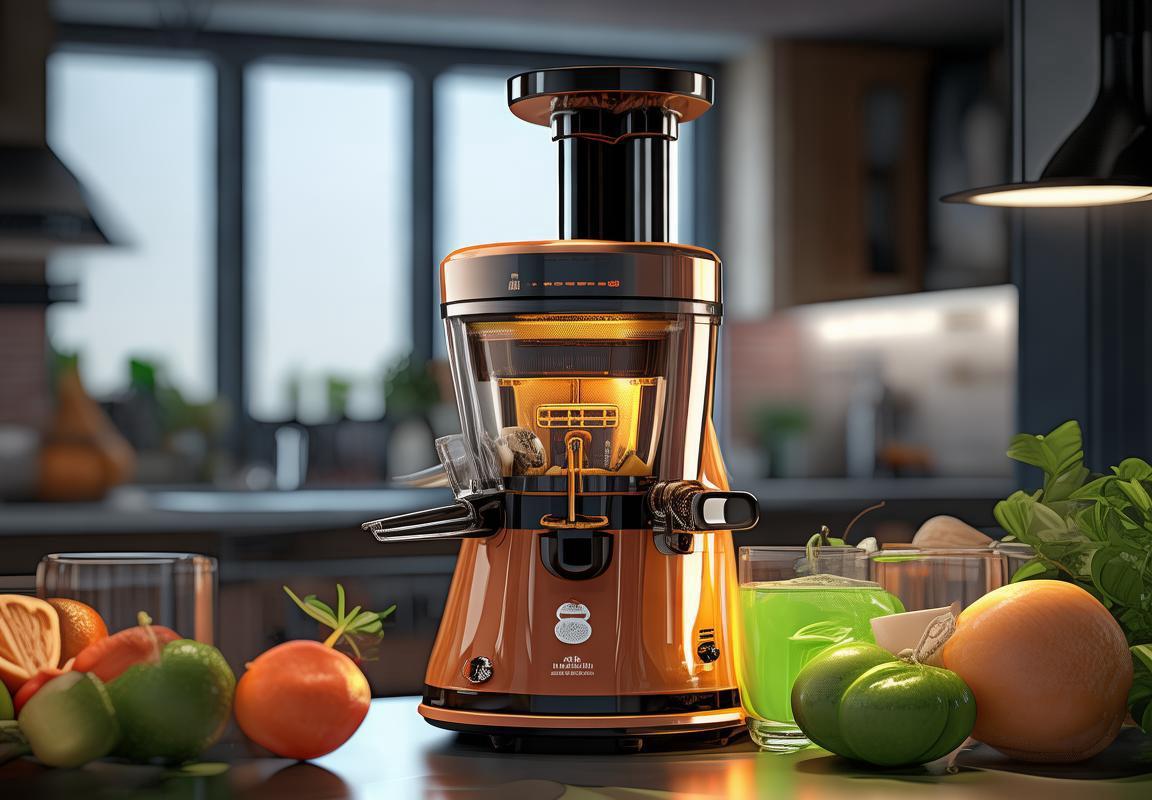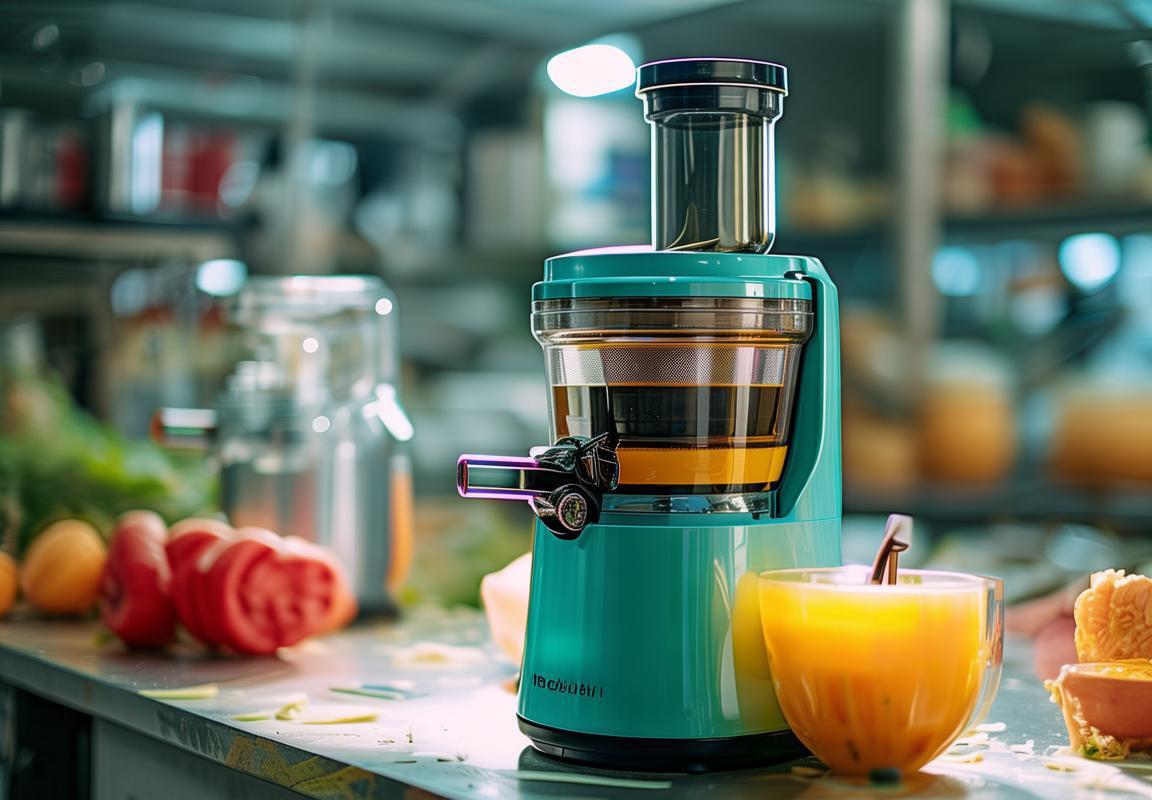In the ever-evolving landscape of kitchen appliances, the role of Original Design Manufacturing (ODM) has become increasingly significant. This article delves into the impact of ODM on juicer design, exploring how this partnership between manufacturers and designers is reshaping the market, fostering innovation, and meeting the diverse needs of consumers. We’ll look at the challenges and opportunities that come with this collaborative approach, as well as the future outlook for ODM juicer design services.
The Rise of ODM in Kitchen Appliances
The landscape of the kitchen appliances industry has undergone a remarkable transformation, with Original Design Manufacturing (ODM) emerging as a pivotal force. This shift has not only reshaped the way products are developed but has also significantly impacted the consumer market. As technology advances and consumer preferences evolve, ODM has become a cornerstone for innovation and market differentiation.
ODM companies, acting as intermediaries between manufacturers and brands, have stepped into the limelight by providing comprehensive design and manufacturing services. This trend has been fueled by the increasing demand for customized, high-quality, and innovative kitchen appliances that cater to diverse consumer needs. By handling the entire design and production process, ODMs have become essential partners for brands looking to establish a strong presence in a competitive market.
The rise of ODM in the kitchen appliances sector can be attributed to several key factors. Firstly, the rapid pace of technological advancements has led to the development of new materials and components that require specialized design expertise. ODMs, with their in-depth knowledge of these technologies, are able to integrate them into appliances, enhancing their functionality and durability.
Secondly, the globalization of the kitchen appliances market has created a diverse customer base with varying preferences. ODMs offer a unique advantage by understanding these nuances and tailoring products accordingly. This localized approach not only ensures that appliances meet specific regional standards but also resonates with the local consumer demographics.
Moreover, the cost-effectiveness of ODM services has made it an attractive option for brands. By outsourcing the design and manufacturing process, companies can reduce overhead costs, streamline operations, and focus on their core competencies. This cost efficiency has been particularly beneficial for small and medium-sized enterprises (SMEs) looking to enter the market without significant upfront investment.
In the European market, the demand for eco-friendly and energy-efficient appliances has surged. ODMs have played a crucial role in designing appliances that not only meet these environmental standards but also offer advanced features and aesthetics. The European consumer’s preference for sustainable living has driven ODMs to innovate in areas such as smart technology integration and energy conservation.
Similarly, the American juicer market has witnessed a shift towards healthier lifestyles, prompting a demand for high-quality, easy-to-use juicers. ODMs have responded by creating sleek, durable, and efficient juicers that cater to the busy lifestyles of American consumers. The emphasis on convenience and performance has been a key driver in this market segment.
One cannot overlook the role of design in the success of ODM in the kitchen appliances industry. Aesthetics and user experience are now just as important as functionality. ODMs have honed their design capabilities to create appliances that not only look appealing but are also intuitive to use. This focus on design has helped brands stand out in a crowded marketplace.
Collaboration between brands and ODMs has led to groundbreaking products that push the boundaries of innovation. For instance, ODMs have been instrumental in developing juicers with smart features, such as automatic cleaning and online connectivity, which provide added convenience to the consumer. These collaborations have also resulted in the creation of modular appliances that can be customized to meet the evolving needs of the market.
Despite the numerous benefits, the ODM landscape is not without its challenges. Ensuring quality control, managing intellectual property rights, and navigating complex regulatory environments are just a few of the hurdles that ODMs must overcome. However, the industry’s adaptability and commitment to continuous improvement have allowed them to thrive in these circumstances.
Looking ahead, the future of ODM in the kitchen appliances industry appears bright. As consumer expectations continue to rise and technology advances further, ODMs are well-positioned to lead the charge in developing the next generation of kitchen appliances. From smart kitchen solutions to sustainable innovations, the possibilities are endless.
In conclusion, the rise of ODM in the kitchen appliances industry is a testament to the power of innovation and collaboration. By combining their technical expertise with a deep understanding of consumer needs, ODMs have become indispensable in shaping the future of kitchen appliances. As the industry continues to evolve, ODMs will undoubtedly play a pivotal role in bringing cutting-edge products to market.

Understanding ODM Juicer Design Service
In the ever-evolving landscape of kitchen appliances, the concept of Original Design Manufacturing (ODM) has emerged as a game-changer. This service, particularly in the juicer industry, has redefined how products are developed and brought to market. Let’s delve into the intricacies of ODM juicer design service and its significance.
ODM stands for Original Design Manufacturing, a business model where the manufacturer designs, develops, and produces products that are sold under another company’s brand. In the context of juicers, this means that a specialized manufacturer can craft unique and innovative designs tailored to the specific needs and preferences of a brand or retailer.
The process of ODM juicer design service involves a series of steps that ensure the final product aligns with the brand’s vision and market demands. From initial concept to final production, here’s a closer look at what this service entails.
-
Market Research and Trend AnalysisBefore diving into design, extensive market research is conducted. This includes analyzing current trends, consumer preferences, and competitive products. By understanding the market landscape, designers can create juicers that not only meet but also exceed consumer expectations.
-
Conceptualization and PrototypingOnce the market research is complete, the creative process begins. Designers conceptualize various ideas, often starting with sketches and 3D models. Prototypes are then created to visualize these concepts and test their feasibility. This stage is crucial for ensuring that the juicer design is not only visually appealing but also functional and user-friendly.
-
Innovation and CustomizationOne of the key advantages of ODM juicer design service is the ability to innovate. Manufacturers can incorporate the latest technologies and materials into their designs, making them stand out in a crowded market. Customization is also a hallmark of ODM, allowing brands to add unique features or branding elements that resonate with their target audience.
-
Engineering and Quality ControlThe design phase is followed by engineering, where the prototype is translated into a manufacturing-ready design. This involves detailed technical drawings and specifications. Throughout this process, quality control measures are implemented to ensure that the final product meets the highest standards of performance and safety.
-
Brand IntegrationODM juicer design service often includes the integration of the client’s brand identity. This goes beyond just adding a logo; it involves creating a cohesive design that reflects the brand’s values, aesthetics, and messaging. The goal is to create a juicer that not only performs well but also reinforces the brand’s image in the consumer’s mind.
-
Testing and IterationBefore the product is released to the market, it undergoes rigorous testing. This includes performance testing, durability testing, and user experience testing. Feedback from these tests is used to make necessary adjustments, ensuring that the final product is as close to perfect as possible.
-
Production and Supply Chain ManagementOnce the design is finalized and tested, the production phase begins. ODM manufacturers manage the entire supply chain, from sourcing materials to manufacturing and logistics. This end-to-end service ensures that the brand receives a high-quality product that is delivered on time.
-
Post-Production SupportThe relationship between the ODM manufacturer and the brand doesn’t end after production. ODM providers often offer post-production support, including maintenance and repair services, which can help maintain the brand’s reputation and customer satisfaction.
The ODM juicer design service has become increasingly popular due to several reasons:
- Cost-Effectiveness: By outsourcing design and production, brands can reduce costs associated with in-house design teams and manufacturing facilities.
- Speed to Market: ODM allows for a faster time-to-market as manufacturers are equipped to handle all aspects of the production process.
- Quality Assurance: ODM providers are committed to quality and can ensure that every product meets the highest standards.
- Flexibility: Brands can choose from a range of designs and specifications, allowing them to cater to different market segments.
In conclusion, the ODM juicer design service is a comprehensive solution that combines innovation, customization, and quality to create unique kitchen appliances. As the demand for personalized and high-quality products continues to grow, ODM is poised to play a pivotal role in shaping the future of the juicer industry.

The European and American Juicer Markets
The European juicer market has seen a significant transformation over the years, evolving from simple citrus squeezers to sophisticated multi-functional appliances. Consumers in Europe are increasingly health-conscious, leading to a surge in demand for juicers that can extract the maximum nutrients from fruits and vegetables. This shift has given rise to a variety of juicers, from centrifugal models that are efficient and easy to clean to masticating juicers that offer a quieter operation and retain more vitamins and minerals.
In recent years, the European market has been characterized by a strong preference for eco-friendly and sustainable products. This has led to an increase in the popularity of juicers made from recycled materials and those that are energy-efficient. Brands that can offer a balance between performance and environmental responsibility often find a loyal customer base. The market is also witnessing a rise in subscription-based services that deliver fresh, organic produce, which in turn drives the demand for high-quality juicers.
On the other side of the Atlantic, the American juicer market has a different set of dynamics. Americans have a long-standing tradition of convenience and innovation, which is reflected in the juicer market. The U.S. market is dominated by centrifugal juicers due to their speed and ease of use. These juicers are perfect for busy lifestyles, as they can quickly process a large amount of produce.
However, the American consumer is also interested in health and wellness, leading to a growing segment of masticating juicers and cold-press juicers. These models are favored for their ability to extract more juice and their gentle extraction process, which preserves the nutritional value of the ingredients. The rise of juice bars and smoothie shops has also contributed to the popularity of these more premium juicers.
The American market is highly competitive, with numerous brands vying for market share. This competition has driven innovation, with manufacturers constantly looking to improve their products. Features such as reverse functions to clear pulp and foam, variable speed settings, and built-in pulp collectors are becoming standard in many models. Additionally, the American juicer market is seeing a trend towards juicers that can handle a variety of ingredients, from leafy greens to nuts and grains, catering to the needs of health enthusiasts and those interested in raw food diets.
In Europe and America, the juicer market is also influenced by the availability of different produce. In Europe, the variety of fruits and vegetables is vast, which means juicers need to be versatile to accommodate a wide range of ingredients. Conversely, in the U.S., the availability of certain fruits and vegetables can be seasonal, which may affect consumer preferences and the types of juicers that are in demand.
Both markets are also seeing a rise in smart technology integration. Juicers with digital displays, Bluetooth connectivity, and even juicing recipes pre-programmed into the appliance are becoming more common. These features not only enhance the user experience but also provide valuable information to help consumers make informed choices about their health and nutrition.
In conclusion, the European and American juicer markets are distinct yet interconnected. They both reflect the global trend towards health and wellness, but they cater to different consumer preferences and market dynamics. Understanding these nuances is crucial for manufacturers looking to succeed in either region, as it requires a nuanced approach to product design, marketing, and distribution.

The Impact of ODM on Juicer Design
The ODM (Original Design Manufacturer) model has revolutionized the kitchen appliances industry, particularly in the realm of juicer design. This approach has brought about a series of transformative changes that have not only shaped the market but also enhanced consumer experiences. Let’s delve into the ways ODM has impacted juicer design.
ODM has allowed for a surge in product diversity. By working closely with clients, manufacturers can create unique designs that cater to specific market needs or niche preferences. This has led to a wide array of juicers, each with its own set of features and aesthetics, ranging from sleek, modern models to those with traditional designs.
Customization has become a hallmark of ODM in juicer design. Brands can now offer juicers that are tailored to their specific brand identity, ensuring that the product aligns perfectly with their marketing strategies. This level of personalization has not only helped in brand differentiation but has also opened up new avenues for creative and functional innovation.
The integration of technology is a significant outcome of the ODM process. With the help of specialized designers, juicers are now equipped with cutting-edge features such as smart controls, advanced filtration systems, and even connectivity to smart home devices. These technological advancements have made juicers not just a kitchen appliance but a part of the digital home ecosystem.
Quality control has been significantly enhanced through ODM. As manufacturers take on the responsibility of designing and producing the product, they can implement stricter quality standards. This focus on quality has resulted in juicers that are more reliable, durable, and efficient, providing consumers with a product they can trust.
Cost-effectiveness is another area where ODM has made an impact. By streamlining the design and production process, manufacturers can often reduce costs without compromising on quality. This has allowed brands to offer competitive pricing, making high-quality juicers more accessible to a broader consumer base.
Market trends are closely monitored and integrated into ODM juicer design. Whether it’s the growing demand for eco-friendly products or the popularity of health and wellness, ODM companies are adept at adapting designs to meet these shifting consumer preferences. This agility has enabled brands to stay ahead of the curve and capitalize on emerging trends.
Sustainability has become a key focus in juicer design, largely due to the influence of ODM. Eco-friendly materials, energy-efficient designs, and recyclable components are now common in juicers. This shift towards sustainability not only benefits the environment but also appeals to environmentally conscious consumers.
Collaboration between brands and manufacturers is at the heart of the ODM model. This partnership fosters a creative environment where ideas can be freely exchanged and developed. The result is a more collaborative and open-minded approach to juicer design, leading to innovative solutions that might not have been possible otherwise.
The ODM process has also led to a more global perspective in juicer design. As manufacturers work with clients from various regions, they gain insights into different cultural preferences and usage patterns. This international collaboration has resulted in juicers that are not only well-suited for specific markets but also adaptable to a wide range of consumer needs worldwide.
Lastly, the ODM model has encouraged a culture of continuous improvement in juicer design. Regular feedback from consumers and the market allows for the refinement of existing models and the development of entirely new concepts. This iterative process ensures that juicers evolve to meet the changing demands and expectations of consumers.
In conclusion, the impact of ODM on juicer design is profound. It has expanded the possibilities for product innovation, improved quality and efficiency, and allowed for a more targeted and responsive approach to consumer needs. As the kitchen appliances market continues to evolve, the role of ODM in shaping the future of juicer design is undeniable.

Challenges and Opportunities in the ODM Juicer Design Service
In the world of juicer design, the role of Original Design Manufacturing (ODM) has grown significantly, offering both challenges and opportunities. Balancing creativity, functionality, and market demands can be a delicate task, but the potential rewards are substantial.
Design Customization and Market ResponsivenessCustomization is a cornerstone of the ODM juicer design service. Manufacturers are increasingly seeking partners who can tailor their juicers to specific market needs, whether it’s adapting to regional tastes, dietary trends, or technological advancements. This flexibility requires a deep understanding of both the product and the end-user, ensuring that each design is not only innovative but also market-responsive.
Quality Control and ConsistencyEnsuring high-quality juicers in the ODM process can be challenging. Quality control measures must be stringent to maintain brand integrity and customer satisfaction. Consistency in design and production across multiple orders is crucial, as a single deviation can affect the perception of the brand and the reliability of the product.
Navigating Global Supply ChainsThe ODM juicer design service often involves complex global supply chains. From sourcing raw materials to managing production and distribution, the process requires a careful balance to avoid delays and cost overruns. Manufacturers must also consider the environmental impact of their supply chains, as sustainability is becoming a key factor in consumer choices.
Intellectual Property and Legal ConsiderationsProtecting intellectual property is paramount in the ODM market. Designers and manufacturers must navigate legal waters to ensure that their creations are protected and that they are not infringing on the rights of others. This includes patents, trademarks, and copyright laws, which can vary greatly across different countries and regions.
Innovation and Technological IntegrationStaying ahead in the juicer market requires constant innovation. ODM partners must be adept at integrating new technologies, such as smart features, improved juicing mechanisms, and eco-friendly materials. This push for innovation must be balanced with practicality, ensuring that the end product is not only cutting-edge but also user-friendly.
Consumer Preferences and Health TrendsUnderstanding consumer preferences and health trends is vital in the juicer industry. ODM services must cater to a diverse range of consumers, from health-conscious individuals seeking organic produce options to families looking for convenient, time-saving appliances. Keeping abreast of these trends and translating them into effective product designs is a challenge but also a significant opportunity.
Market Entry and ExpansionFor manufacturers looking to enter new markets, the ODM juicer design service can be a gateway. Adapting designs to local standards, cultural nuances, and market demands is critical for successful market entry. At the same time, established brands can leverage ODM to expand their product lines and cater to niche markets, which can lead to new revenue streams.
Cost Management and Profit MarginsCost management is a constant concern in the ODM juicer design service. Balancing cost efficiency with premium design features is a delicate act, as over-investment in design can erode profit margins. Manufacturers must find the sweet spot where they can offer high-quality, innovative designs without compromising on cost-effectiveness.
Sustainability and Environmental ResponsibilityAs consumers become more environmentally conscious, the ODM juicer design service must address sustainability concerns. This includes using eco-friendly materials, minimizing waste during production, and designing appliances that are energy-efficient. Sustainable practices not only appeal to eco-conscious consumers but can also reduce long-term operational costs for manufacturers.
Market Saturation and DifferentiationThe juicer market is becoming increasingly saturated, making differentiation a key challenge for ODM partners. Designers must create unique selling propositions (USPs) that set their juicers apart from the competition. This could be through innovative features, stylish aesthetics, or exceptional performance, all of which require careful consideration and execution.
Training and DevelopmentThe success of the ODM juicer design service relies on the skills and knowledge of the design team. Continuous training and development are essential to keep up with the latest design trends, materials, and production techniques. Investing in the team’s growth ensures that the service remains competitive and can adapt to changing market conditions.
In conclusion, the ODM juicer design service faces a multitude of challenges and opportunities. From customizing designs to managing global supply chains and staying ahead of health trends, the path is complex but rewarding. By navigating these challenges with a strategic approach, manufacturers can tap into new markets, differentiate their products, and ultimately, drive business success.

Future Outlook for ODM Juicer Design Service
The future of the ODM (Original Design Manufacturing) juicer design service is a landscape that’s brimming with potential and challenges alike. As technology advances and consumer preferences evolve, the role of ODM in shaping the juicer market is poised to grow significantly. Here’s a glimpse into what lies ahead:
Innovation in Materials and TechnologyMaterials science is advancing at a rapid pace, and this trend is expected to influence the ODM juicer design service. New materials with enhanced durability, ease of cleaning, and aesthetic appeal are likely to become more prevalent. Additionally, advancements in technology, such as the integration of smart features and wireless connectivity, could redefine the juicer market.
Customization and PersonalizationThe demand for customized and personalized products is on the rise, and juicers are no exception. ODM juicer design services are likely to see an increase in requests for tailored solutions that cater to specific consumer needs or regional preferences. This could involve everything from unique color schemes to specialized functions like cold-press technology.
Sustainability and Eco-Friendly DesignsAs environmental concerns grow, so does the demand for eco-friendly products. The ODM juicer design service will need to adapt by offering designs that are not only sustainable but also appeal to environmentally conscious consumers. This could mean using recycled materials, designing for longer life cycles, and ensuring that the juicers are energy-efficient.
Global Market ExpansionThe global juicer market is expanding, with new markets emerging in Asia and Africa. ODM juicer design services will have the opportunity to tap into these markets by creating products that align with local tastes and cultural preferences. This expansion will require a deep understanding of international regulations and standards.
Regulatory ComplianceNavigating the complex web of international regulations is a challenge for any ODM juicer design service. As new regulations are introduced, particularly in areas like safety standards and emissions, ODM providers will need to stay ahead of these changes to ensure their products meet the necessary requirements.
Consumer Health TrendsThe health and wellness industry is booming, and this trend is expected to continue. ODM juicer design services will need to focus on creating products that cater to this market, with features that support healthier lifestyles, such as nutritional analysis, juice storage solutions, and easy-to-use interfaces.
Competitive LandscapeThe competitive landscape in the juicer market is fierce, with numerous players vying for market share. ODM providers will need to differentiate their services by offering unique design solutions that stand out in terms of innovation, functionality, and brand appeal.
Cost-Effective SolutionsAs the cost of living continues to rise, consumers are increasingly looking for cost-effective solutions. ODM juicer design services may need to develop more affordable options without compromising on quality, making efficient use of materials and design to keep costs down.
Collaboration with BrandsThe success of ODM juicer design services often hinges on strong collaborations with brands. These partnerships will need to be fostered and maintained, with a focus on shared goals and a mutual understanding of the market landscape.
Technological IntegrationThe integration of technology into everyday appliances is a trend that’s not likely to slow down. ODM juicer design services will need to stay abreast of technological advancements and incorporate them into their designs, ensuring that juicers remain at the forefront of smart kitchen technology.
Market Research and TrendsTo thrive in the ODM juicer design service, staying informed about market trends and consumer behavior is crucial. Continuous market research will be essential to anticipate changes and adapt design strategies accordingly.
In conclusion, the future of the ODM juicer design service is dynamic and multifaceted. From embracing technological advancements to catering to health-conscious consumers and navigating a complex regulatory environment, the industry will require a combination of innovation, market intelligence, and strategic partnerships to succeed.

Conclusion
In reflecting on the journey of the ODM (Original Design Manufacturer) juicer design service, one can’t help but see a landscape rich with evolution and innovation. The transformation of the juicer from a simple kitchen gadget to a centerpiece of health-conscious lifestyles is a testament to the dynamic nature of the market.
As we delve into the nuances of this service, the collaborative nature of ODM has become increasingly apparent. Designers and manufacturers work hand in hand, blending creative vision with practical expertise to produce juicers that not only appeal to the eye but also to the user’s experience. The rise of the ODM service has sparked a wave of customization that has allowed brands to differentiate themselves in a crowded marketplace.
The challenges that accompany this service, such as navigating complex regulations and keeping up with the ever-changing consumer preferences, have led to the development of more agile and customer-centric design processes. These hurdles have also driven the industry to invest in research and development, pushing the boundaries of juicer technology and functionality.
Looking ahead, the future of the ODM juicer design service is poised to be marked by several key trends. The integration of smart technology is set to become more prevalent, offering users not just a tool for juicing but a comprehensive health management system. Sustainability is another critical factor, with an increasing focus on eco-friendly materials and energy-efficient designs.
Brands that embrace these trends will likely find themselves at the forefront of the market. The ability to offer a juicer that is not only effective but also sustainable and technologically advanced will be a significant competitive advantage. Moreover, as the market becomes more global, the ODM service will play a crucial role in adapting products to meet the diverse needs of international consumers.
The ODM juicer design service has also opened up new opportunities for collaboration and growth. Manufacturers can expand their product lines with ease, while designers can explore their creativity across a variety of brands and markets. This symbiotic relationship has led to a proliferation of unique and innovative juicer designs, each catering to specific user demographics and lifestyle choices.
In conclusion, the ODM juicer design service has not only streamlined the process of bringing new products to market but has also enhanced the quality and variety of juicers available to consumers. The journey from initial concept to finished product is now a testament to the power of partnership and innovation. As the market continues to evolve, the ODM service will undoubtedly play a pivotal role in shaping the future of juicer design, ensuring that the next generation of juicers will not only be functional and stylish but also a reflection of the changing world we live in.